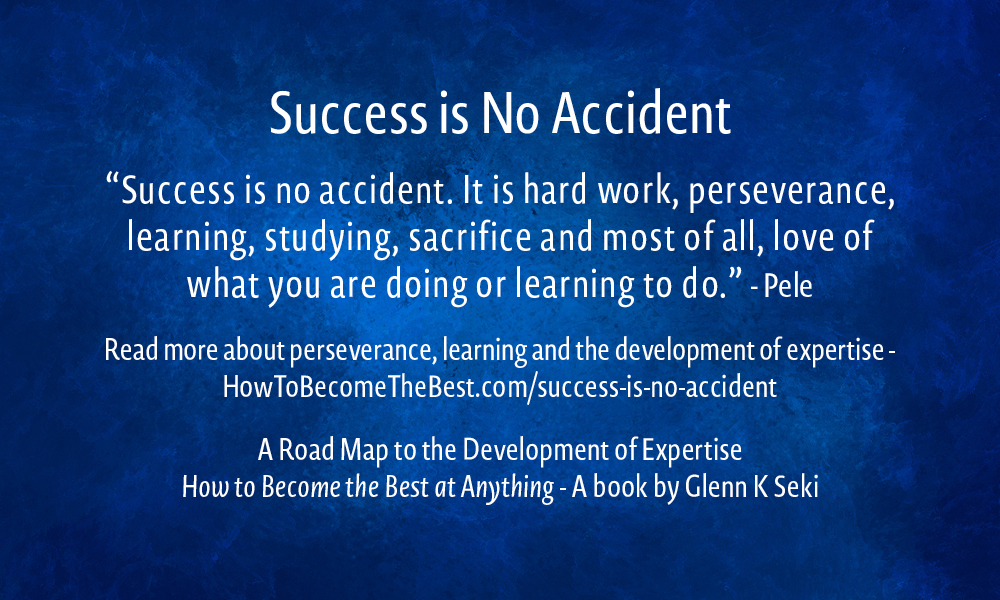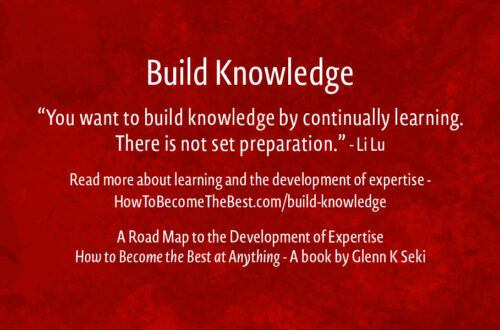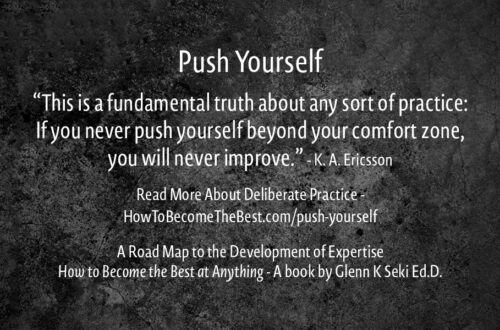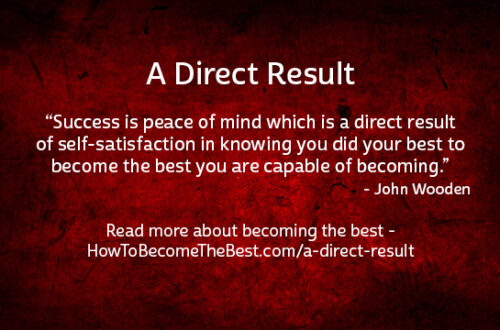“Success is no accident. It is hard work, perseverance, learning, studying, sacrifice and most of all, love of what you are doing or learning to do.” – Pele
Perseverance, Learning and the Development of Expertise
Persistence and Motivation
An excerpt from How To Become The Best at Anything, Chapter 9, Persistence, Motivation, and More About Your Path
“Keep practicing no matter what. It will take years, you know this, so you have to keep practicing. You have to keep practicing getting better every time you practice. This is a very hard thing to do. You will get tired, bored, and frustrated. It is hard to keep your focus while practicing.
I heard a story about John Wooden (often considered one of the greatest college basketball coaches, ever) while I was a student at UCLA. During practice one of the basketball players was not practicing very hard. John Wooden pulled him aside and asked the player what was wrong. He was only working at 70%. He told his coach he was very tired and that he would give 200% at the next practice. Wooden said, one can only give 100% at any given time, so go out there and give me 100% today, tomorrow, and the next day. The player went out and gave 100% for the rest of practice. You have to give 100% every time you practice.
The motivation to keep practicing and to practice 100% of the time to get better is probably the key to becoming the best. This is probably the hardest thing to do. You have to be motivated for years and over 10,000 hours of practice.”
How Motivation Works
“Basically, there are two types of motivation, extrinsic and intrinsic. Extrinsic motivation come from an outside source and intrinsic motivation comes from inside you. (To help you remember, Extrinsic, Ex = Exit = motivation from outside, Intrinsic, In = Inside = motivation from inside.)
Extrinsic motivation is like when your mother bribed you as a child with candy to do something. Receiving candy was your extrinsic motivation to do what your mother wanted you to do.
When you try something new and you receive praise from someone you value, this is extrinsic motivation to continue practicing. A child has been watching her father play the piano. The child sits down at the piano and plays a few notes. The father praises the child. The child feels good and is motivated to play more.
Sometime later the child has grown to love playing the piano for the joy it brings her. She no longer needs the praise from a parent, teacher, or friend. She loves playing for the satisfying feeling it gives her inside.
Intrinsic motivation is when you want to do something because YOU really want to do it, not because someone else wants you to do it. This is the kind of motivation you need to become the best.
You need to be very passionate about what you want to become in order to become the best. This passion will be your intrinsic motivation that will drive you to keep going and keep practicing even when a part of you wants to quit.”
Staying on Your Path
“Once you have traveled your path for awhile you will have some successes and some failures. You take the successes and use them to help fortify your resolve and your belief in yourself that you can reach your goal. You take the failures and use them to learn about your weak points and guide your practice, so your weak points become your strong points.
You need to expect that you will do well. You need to expect that you will have failures. You need to believe that you can learn from your successes and failures. You need to believe that hard work and persistence will help you reach your goal.”
How You Feel About Yourself
“Here is some academic educational jargon, self-esteem vs self-efficacy. You need to understand the difference between them because there is a lot of misinformation about how you need to have high self-esteem to have high achievement. This is not so.
You have probably heard of self-esteem. If you feel good about yourself, you are generally thought to have high self-esteem. Unfortunately, this does not mean you will be a high achiever in the domain you are trying to become the best.
You might not be very popular at school, but you are a math wiz. You know you can do anything when it comes to math, but you feel awkward in social settings, you only have a couple of friends, you aren’t popular, and you don’t feel good about yourself. You have low self-esteem.
When you are in your domain of math, working very complex problems, putting lots and lots of time to get better at math you feel very good about yourself when it comes to math. This is called having high self-efficacy in the domain of math. Self-efficacy is domain specific and high self-efficacy in a domain leads to higher achievement. This means you can be very confident in a specific domain, be very successful in that domain, but have low self-esteem.
You need to be successful in the domain in which you are trying to become the best. Success leads to more success. A little success in the beginning leads to more and more success. The belief that you can be successful in your domain is key to your success. This will keep you going when you have failures. You have to believe that hard work, deliberate practice, etc. will make you successful. This is high self-efficacy in a particular domain. You can feel bad about yourself in one area but have great success and achievement in another. Focus on the successes in the domain you are trying to become the best and use that to help motivate you to keep going. You must persist to become the best.
You also need to feel like you are in control of your successes and failures.”
How you learn something…
An excerpt from How To Become The Best at Anything, Chapter 8, Deliberate Practice and Learning
Learning
“When you are trying to learn something new or you are teaching someone something new, it can be a very daunting task. It is difficult because learning something new is not easy, but it can be made easier if you understand how learning works.
Learning can be divided into four basic parts: concepts (definitions and examples), processes (how it works sequences), principles (cause and effect relationships), and productions (procedures/classifications).”
Concepts
“Here’s a common example of a concept: a chair. You can look at one and tell right away that it is a chair. A chair can have four legs, three legs, two legs, one leg, or no legs. A chair can have more than four legs. Your memory stores a definition and examples of chairs. You have learned the concept of a chair. To learn a new concept, you need a definition and examples of the concept.
Learning a concept sounds easy, and it is. However, you can run into problems when you have a lot of new concepts to learn in a short amount of time. In a typical high school biology class, a student will be given more vocabulary to learn (concepts) than in an average first-year high school foreign language class. I taught high school biology and many of my students struggled with the vocabulary. I would help them learn the new concepts by presenting them in different ways. They would first be exposed to the new concepts in their homework. Then in a lab, then in an exercise, and then in group work that would push them to apply the concepts in different ways and would show them how the concepts fit in with processes, principles, and productions.”
Processes
“A process is a “how it works sequence.” An example is how radar (radio detection and ranging) works. You have probably seen a radar device in movies and on television. Someone is looking at a screen and they are watching an airplane or missile in flight as it approaches.
A magnetron generates high-frequency radio waves, which are then sent to an antenna. The antenna acts as a transmitter, sending a narrow beam of radio waves through the air. The radio waves hit the airplane and are reflected back. The antenna picks up these reflected waves (usually the same antenna). The signal is then sent to a receiver. A computer in the receiver processes the reflected waves and renders them on the screen.
The sequence: antenna sends electromagnetic waves out – electromagnetic waves hit the airplane – electromagnetic waves reflect back – antenna receives the electromagnetic waves – computer draws them on a screen. Since you know the direction you sent out the electromagnetic waves, the speed of the electromagnetic waves and you know the time that has expired, you know the distance and direction to the plane.
Simple? Maybe not. You had to understand a number of concepts; electromagnetic waves, antenna, airplane, reflection, magnetron, etc. You probably didn’t know the concept, magnetron (a magnetron is a high-powered vacuum tube that works as a self-excited microwave oscillator), and this was a simplified version of how radar works. To learn a process, you need to have already learned the concepts in the process.
Remember Alma, the musical child prodigy? She has a process she has developed for when she gets “stuck” in a composition. In her mind, she goes to an imaginary country which she has invented, that is populated with many composers that write in their own style of emotion. She will ask them for advice and “quite often, they come up with very interesting things.” While I was unable to find her exact step-by-step process, she definitely seems to have a very elaborate process to help her when she gets “stuck.””
Principles
“Principles are cause and effect relationships. In other words, if this occurs then that happens. If that occurs then that doesn’t happen. I touch a hot pan on the stove, I burn my hand. I touch a cold pan on the stove, I don’t burn my hand. And I’m able to pick it up.
When I was working as a photographer for LMU and covering a basketball game, a fast break would occur, and the players would be running towards me. I already understood the process for this LMU’s basketball team’s fast break strategy (how their fast break plan works). If player #1 has the ball the team will drive for a layup or dunk. If player #2 has the ball that player will stop at the three-point line and put up a shot. If player #3 has the ball, the ball will be passed to players #1 or #2, and so on. I already had learned this team’s process and principle for a fast break. This allowed me to anticipate their actions and have the appropriate camera and lens combination, and which player to follow-focus (actively focusing on a moving object). I was able do this without consciously thinking about it because I had automated the procedure. Since I was manually focusing on their eyes, with a short telephoto lens (85mm f1.2), as they ran toward me on the basketball court, having the procedure automated allowed me to “get the shot.””
Productions
“Productions are procedures and classifications. This is the biggie! This is what you are trying to do to gain high levels of expertise. You want to automate procedures and classifications, so you don’t have to consciously think about them. Going back to the example of driving a car, you don’t have to consciously think about all the little things that it takes to drive a car in traffic because you have automated a set of procedures. Going back to the chair example, you can look at something and know it is a chair without consciously thinking about it because you have automated the classification of a chair. Going back to my photographing a basketball fast break example, I had all the concepts, processes, and principles I needed to get the shot and they had become automated so it was more like a reflex than a conscious action. I didn’t have to think about it, I just did it.”
“This is the goal of performing deliberate practice, the 10,000 hours, to automate procedures and classifications. To get there you need the concepts, processes, principles, and productions. Remember, you must automate the productions correctly. If you automate them incorrectly it will take a lot of work and time to un-automated it.
How do you practice? What do you practice? That depends on what domain and what production you are trying to automate. This is another reason why you need a coach. Your coach will help you with drills and practices to perform.”





